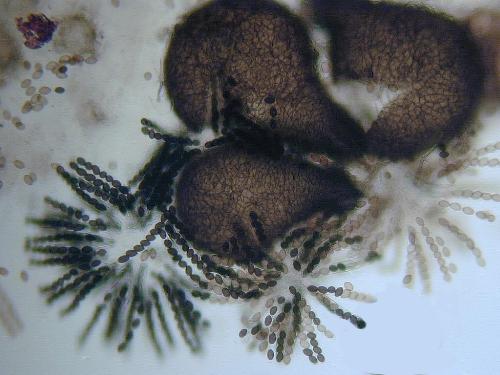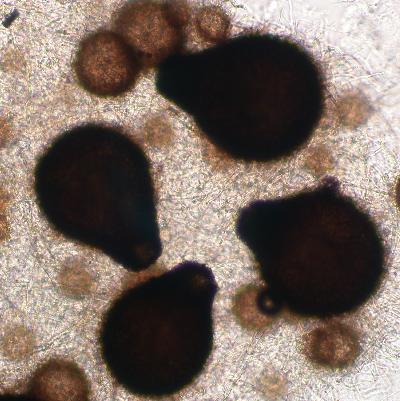Please click
TomVolkFungi.net for the rest of Tom Volk's pages on fungi
 In honor of the 24th Fungal Genetics Conference at Asilomar, California, this month's fungus is Sordaria fimicola, an important model organism for Genetics classes all over the world. Sordaria fimicola's interesting life cycle can be used to verify Mendel's laws of segregation directly, not just statistically.
In honor of the 24th Fungal Genetics Conference at Asilomar, California, this month's fungus is Sordaria fimicola, an important model organism for Genetics classes all over the world. Sordaria fimicola's interesting life cycle can be used to verify Mendel's laws of segregation directly, not just statistically.
Of course you remember Gregor Mendel as "that pea guy," well known for his pioneering genetics work with Pisum sativum, the garden pea. Mendel was a Austrian monk who apparently had a lot of time on his hands. He was the gardener in his monastery (which at that time was in Austria, now in Brno in the Czech Republic) and noticed that there was some variation in the way the peas looked: whether the stem was tall or short, whether the peas were smooth or rough, green or yellow, and so on. He thought that there must be something that was passed on through the generations of peas that dictated the phenotype of the peas, i.e. what they looked like. Through a series of very careful experiments, he meticulously crossed peas with different genotypes to see what their offspring looked like. He found that many of the traits seemed to be independent of one another and came up with his Law of Independent Assortment. We now know that Mendel's pea traits assort independently because they are on different chromosomes. Mendel also did crosses of true-breeding tall plant with true-breeding short plants. Mendel found that all of their offspring were tall. The prevailing theory of the time suggested that traits were "blended" in offspring, but Mendel's data argued directly against this. Under the Blending theory, the offspring should have all been intermediate in height. When he crossed these tall offspring with one another, he found a 3:1 ratio of tall:short plants in their progeny. Mendel called this the Law of Segregation, that traits would segregate from one another in the second generation. Mendel thought that there were some segregating "factors" that could account for this phenomenon.
Although Mendel's data were suspiciously good, he could really only account for numbers of offspring, not the products of a single meiotic event. In Mendel's time meiosis was not yet fully understood, so he was unable to discern the reasons for this segregation. We now know that it is the process of meiosis that accounts for these ratios. This is where Sordaria fimicola and related fungi (Neurospora crassa, Aspergillus (=Emericella) nidulans) come into the picture. Without going into all the gory details, because of the way that meiosis occurs in the ascus, the products of meiosis (the tetrad of two pairs of sister chromatids) show up in the ascospores in the exact order in which they separated from one another. This phenomenon is largely due to the narrow cylindrical shape of the ascus, which forces the meiotic spindle to line up parallel to the long axis of the ascus. There just isn't room to divide any other way. In all three of these species, the meiotic division is followed by one mitotic division, resulting in eight spores per ascus.

 The utility of Sordaria in genetics stems from its very strict method of sexual reproduction. It is a member of the Ascomycota, which means that it bears its sexual (meiotic) ascospores in a sac called an ascus. In turn, the asci are borne in a special fruiting structure called a perithecium. All of the asci in one perithecium are more or less conected at their bases, forming a layer of cylinders kind of squished into the perithecium. The perithecium is flask-shaped, which means that it is basically ovoid, but elongated at one end. It's kind of like a Hershey'sTM Kiss, but more much more rounded at the bottom. See the picture to the right, where the perithecia are shown growing on agar plates.The lighter brown dots are immature perithecia. The elongated tip of the perithecium is actually hollow; the hole is called the ostiole. The ostiole allows the ascospores to be discharged into the outside world in an interesting way: the asci elongate into the ostiole one at a time. As the ascus reaches the outside, the ascospores are forcibly discharged via water pressure from within the fruiting body. The spent ascus withers, and a new one grows into the ostiole to take its place. If there is not enough water, the perithecium can dry out and revive to shoot out its spores later. Thus the ascospores can be discharged over a very long period of time, kind of a timed release of spores. To the left you can see an animation of ascospore production from Jim Worrall at ForestPathology.org. It's an excellent site with everything you could want to know about organisms (such as fungi, bacteria, and insects) that cause harm to trees in the forest. Go there now to learn more!
The utility of Sordaria in genetics stems from its very strict method of sexual reproduction. It is a member of the Ascomycota, which means that it bears its sexual (meiotic) ascospores in a sac called an ascus. In turn, the asci are borne in a special fruiting structure called a perithecium. All of the asci in one perithecium are more or less conected at their bases, forming a layer of cylinders kind of squished into the perithecium. The perithecium is flask-shaped, which means that it is basically ovoid, but elongated at one end. It's kind of like a Hershey'sTM Kiss, but more much more rounded at the bottom. See the picture to the right, where the perithecia are shown growing on agar plates.The lighter brown dots are immature perithecia. The elongated tip of the perithecium is actually hollow; the hole is called the ostiole. The ostiole allows the ascospores to be discharged into the outside world in an interesting way: the asci elongate into the ostiole one at a time. As the ascus reaches the outside, the ascospores are forcibly discharged via water pressure from within the fruiting body. The spent ascus withers, and a new one grows into the ostiole to take its place. If there is not enough water, the perithecium can dry out and revive to shoot out its spores later. Thus the ascospores can be discharged over a very long period of time, kind of a timed release of spores. To the left you can see an animation of ascospore production from Jim Worrall at ForestPathology.org. It's an excellent site with everything you could want to know about organisms (such as fungi, bacteria, and insects) that cause harm to trees in the forest. Go there now to learn more!
In the example at the top of this page, you can see three perithecia that have been crushed to release the intact asci all at once. The perithecium on the left is from a self-cross of a mycelium whose DNA coded for dark ascospores. The perithecium on the right was formed by a self-cross of a mycelium whose DNA coded for tan ascospores. The perithecium in the center was formed when the two types of mycelia crossed with one another. You can clearly see the asci that have ascospores of two colors. There are two different patterns-- 4:4 dark:tan spores indicates separation of the genotypes in the first division of meiosis. 2:2:2:2 or 2:4:2 ratio indicates separation of the genotypes in the second division of meiosis.
 Because of its perithecium ("surrounding sheath"), Sordaria fimicola has been classified in the class Pyrenomycetes, along with Xylaria polymorpha, dead man's fingers, Hypomyces lactifluorum, the lobster mushroom, Cordyceps subsessilis, the cyclosporine fungus, and Cordyceps ophioglossoides, a mycoparasitic fungus. However, unlike those four, Sordaria fimicola does not bear its perithecia in or on a stroma, a structure composed of sterile hyphae, but rather bears its perithecia singly on the substrate. This provides less protection for the perithecium, but allow more flexibility in timing of the fruiting for maximum spore discharge. This flexibility is important because the fungus cannot raise its spore bearing structures into the air column with a multicellular stroma, but depends only on the ascospores being discharged fully from the ascus under the proper conditions.
Because of its perithecium ("surrounding sheath"), Sordaria fimicola has been classified in the class Pyrenomycetes, along with Xylaria polymorpha, dead man's fingers, Hypomyces lactifluorum, the lobster mushroom, Cordyceps subsessilis, the cyclosporine fungus, and Cordyceps ophioglossoides, a mycoparasitic fungus. However, unlike those four, Sordaria fimicola does not bear its perithecia in or on a stroma, a structure composed of sterile hyphae, but rather bears its perithecia singly on the substrate. This provides less protection for the perithecium, but allow more flexibility in timing of the fruiting for maximum spore discharge. This flexibility is important because the fungus cannot raise its spore bearing structures into the air column with a multicellular stroma, but depends only on the ascospores being discharged fully from the ascus under the proper conditions.
However, taxonomy of the Ascomycota is in a state of flux. (<--gross understatement). More recent systematics and taxonomic work has shown that the Pyrenomycetes are not monophyletic, i.e. evolved from a common ancestor. Instead, they are polyphyletic, having evolved separately. Recent molecular DNA evidence from sequence comparisons of several regions of DNA have placed Sordaria and the other non-stromatic forms in the Sordariales. Some taxonomic schemes even place these single perithecium formers in their own class, the Sordariomycetes! I think that's getting a little carried away and sidesteps having to decide if they're really related to the stroma formers. I guess time (and a lot more research) will tell. (Incidentally these schemes place Xylaria in the Xylariales and Cordyceps and Hypomyces in the Hypocreales.)
Although Sordaria fimicola is the species most commonly used in genetics classes, for research geneticists use mostly Neurospora crassa and Aspergillus (=Emericella) nidulans. These species are not used because of its abundant asexual reproduction-- the conidia get in the way, especially for beginning Genetics students whose sterile technique may not yet be well developed. Maybe I'll write more about these later.
I hope you enjoyed learning about Sordaria fimicola and the idiosyncrasies of its life cycle that can be exploited in genetics studies. These little dung fungi have risen above their lowly circumstances to serve people.
If you have anything to add, or if you have corrections, comments, or recommendations for future FotM's (or maybe you'd like to be co-author of a FotM?), please write to me at 
This page and other pages are © Copyright 2007 by Thomas J.
Volk, University of Wisconsin-La Crosse.
Learn more about fungi! Go to Tom Volk's Fungi Home Page --TomVolkFungi.net
Return to Tom Volk's Fungus of the month pages listing